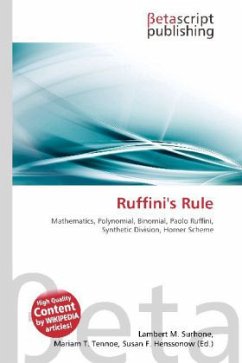Please note that the content of this book primarily consists of articles available from Wikipedia or other free sources online. In mathematics, Ruffini''s rule allows the rapid division of any polynomial by a binomial of the form x r. It was described by Paolo Ruffini in 1809. Ruffini''s rule is a special case of synthetic division when the divisor is a linear factor. The Horner scheme is a fast algorithm for dividing a polynomial by a linear polynomial with Ruffini''s rule. See also polynomial long division for related background. The b values are the coefficients of the result (R(x)) polynomial, the degree of which is one less than that of P(x). The final value obtained, s, is the remainder. As shown in the polynomial remainder theorem, this remainder is equal to P(r), the value of the polynomial at r. It is entirely possible that, when looking for a given polynomial''s roots, we might obtain a messy higher-order polynomial for S(x) which is further factorable over the rationals even before considering irrational or complex factorings. Consider the polynomial x5 3x4 + 3x3 9x2 + 2x 6. Using Ruffini''s method we will find only one root (x = 3); factoring it out gives us P(x) = (x4 + 3x2 + 2)(x 3).








